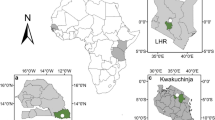Summary
-
1.
Positions and behavior of six male and eight female guinea pigs kept outside in a 12x12 m2 pen with a central shelter were recorded over one month in 288 scans. Data were analyzed by statistical and by information analysis methods. Two main states were distinguished: behavior in the field (‘activity,’ 47%), consisting mainly of feeding (42%); and that at the shelter (‘inactivity,’ 53%), consisting mainly of resting (46%). Only 2% of the observations were of social behavior. Males were about 10% more often active than females, apparently as a result of being subject to more aggressive acts, especially within the resting site. Observations of aggressive interactions also showed one male dominating all others, which were all of equal rank.
-
2.
The daytime distribution of activity showed two peaks at 0600–0700 hours and 1800–2000 hours. Some activity took place during the night. An 18% reduction of uncertainty in prediction of an individual's activity resulted if the time of day was considered, and for group activity (>5 animals active) the reduction was 29%. Activity was socially synchronized within the group, as was shown experimentally. The uncertainty of an average individual's activity was reduced by 29% if group activity was considered.
-
3.
In the shelter, sexes and individuals showed preferences for specific locations. Males kept closer to the entrance. Nearest-neighbor frequencies, huddle frequencies, and frequencies at which animals were inside the shelter at the same time did not differ significantly, but males kept further apart from other animals than did females. In the field, no differences were found in nearest-neighbor frequencies or nearest-neighbor distances. Individuals had preferred areas, and the uncertainty of an average animal's location was reduced by 1% if its identity was known. Location in the field was affected by time of day, knowledge of which reduced the uncertainty of an average individual's position by 9%. Group cohesion affected the animal's position more strongly, however, reducing uncertainty by 16%. Active maintainance of proximity during feeding was shown experimentally.
Similar content being viewed by others
References
Berryman, J.C.: Social behavior in a colony of domestic guinea pigs. Z. Tierpsychol. 46, 200–214 (1978)
Coulon, J.: Les relations sociales chez le cobaye domestique male II: Le comportement agonistique interterritorial. Behaviour 53, 200–216 (1975)
Estabrook, G.W.: An information theory model for character analysis. Taxon 16, 86–97 (1967)
Fagen, R.M.: Information measures: Statistical confidence limits and inference. J. Theor. Biol. 73, 61–79 (1978)
Hartcourt, A.H.: Activity periods and patterns of social inteaction: A neglected problem. Behaviour 56, 121–135 (1978)
Hazlett, B.A., Estabrook, G.F.: Examination of agonistic behavior by character analysis. I. The spider crab Microphrys bicomutus. Behaviour 48, 131–144 (1974)
Jacobs, W.W.: Male-female associations in the domestic guinea pig. Anim. Learn. Behav. 4, 77–83 (1976)
King, J.A.: Social relations of the domestic guinea pig living under semi-natural conditions. Ecology 37, 221–228 (1956)
Kunkel, P., Kunkel, I.: Beiträge zur Ethologie des Hausmeerschweinchens Cavia aperea f. porcellus (L.). Z. Tierpsychol. 21, 602–641 (1964)
Reimer, J.B., Petras, M.L.: Breeding structure of the house mouse, Mus musculus, in a population cage. J. Mammal. 48, 88–99 (1967)
Rood, J.P.: Ethological and behavioral comparison of three genera of Argentine cavies. Anim Behav. Monogr. 5, pt. 1 (1972)
Shannon, C.E., Weaver, W.: The mathematical theory of communication. Urbana: University of Illinois 1964
Siegel, S.: Nonparametric statistics for the behavioral sciences. Tokyo: McGraw-Hill Kogakusha 1956
Steinberg, J.B.: Information theory as an ethological tool. In: Quantitative methods in the study of animal behavior. Hazlett, B.A. (ed.). New York: Academic 1977
Weir, B.: Some notes on the history of domestic guinea pigs. Guinea-Pig Newsletter 5, 2–5 (1972)
Yeomans, K.A.: Statistics for the social scientist: 2. Applied statistics. Harmondsworth: Penguin 1968
Author information
Authors and Affiliations
Rights and permissions
About this article
Cite this article
Fuchs, S. Spacing patterns in a colony of guinea pigs: Predictability from environmental and social factors. Behav Ecol Sociobiol 6, 265–276 (1980). https://doi.org/10.1007/BF00292769
Received:
Accepted:
Issue Date:
DOI: https://doi.org/10.1007/BF00292769




